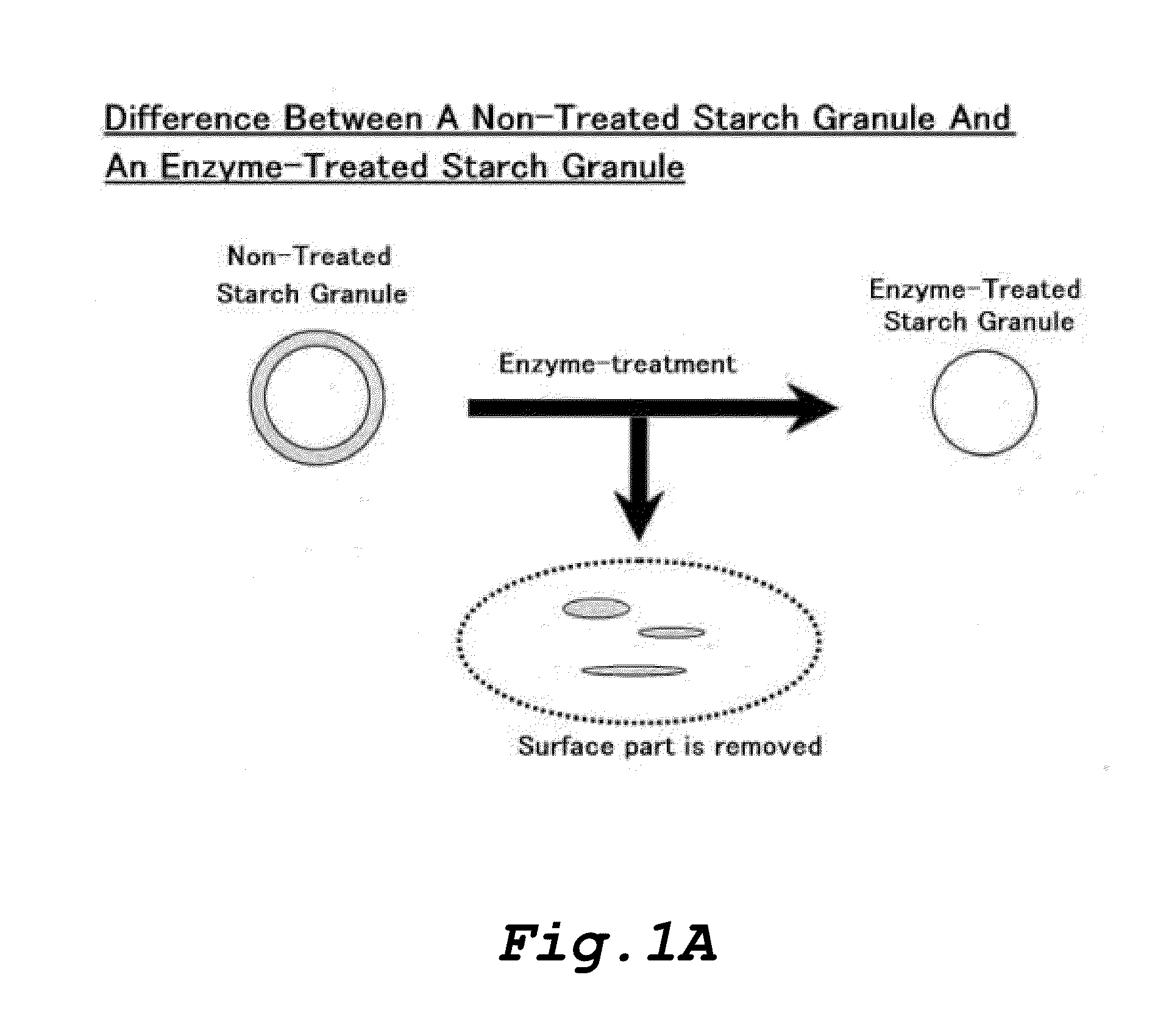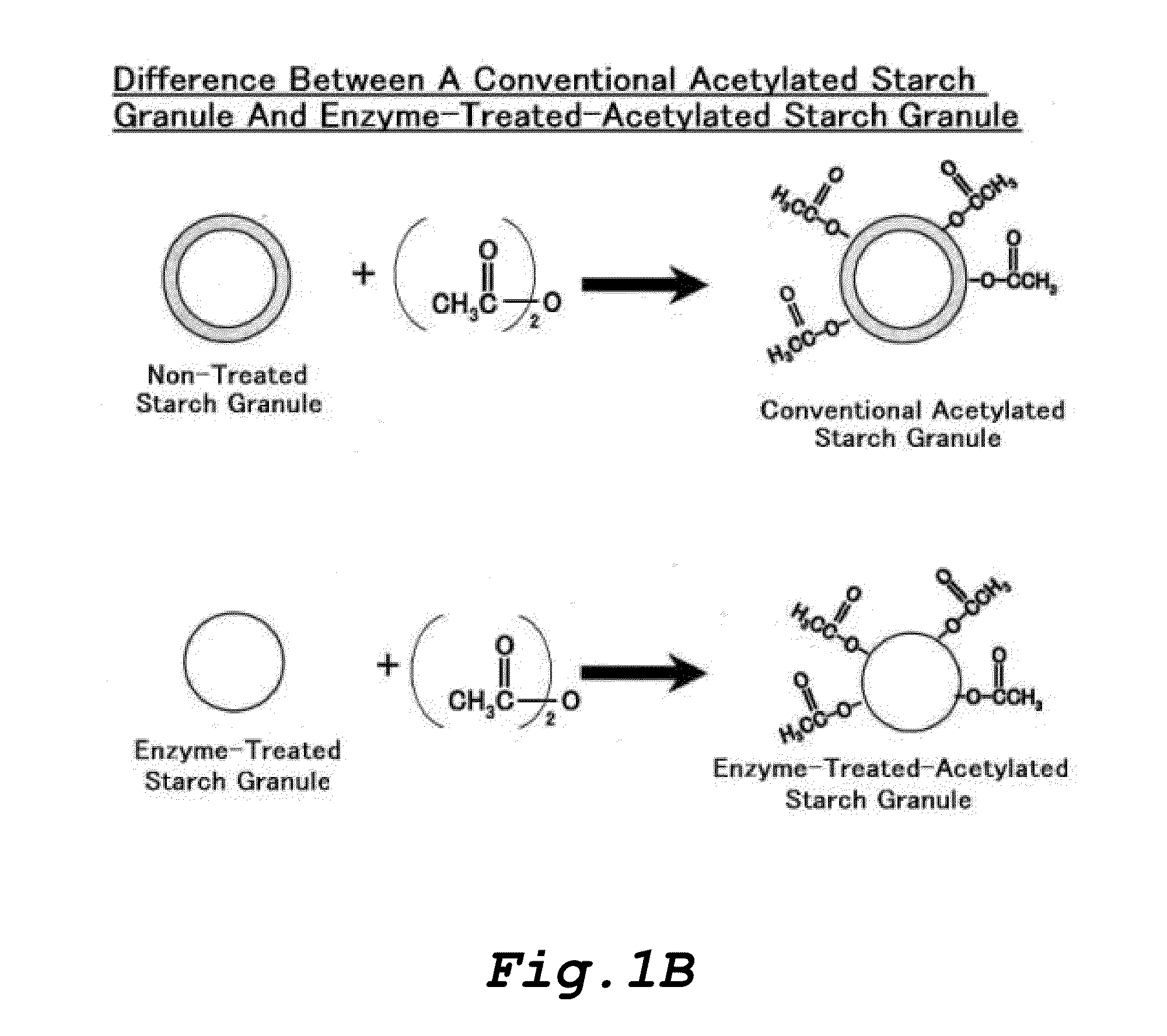Food product containing starch gel, starch granule, production method and use thereof
- Summary
- Abstract
- Description
- Claims
- Application Information
AI Technical Summary
Benefits of technology
Problems solved by technology
Method used
Image
Examples
examples 1-1 and 1-2
[0453]To 400 g of an untreated native wheat starch of the same lot as what was used in Comparative Example 1,900 g of ion-exchange water was added to prepare a starch suspension. After adjusting the pH of the suspension to 5.0, 0.1% by weight (based on starch solid content) of α-amylase (“Biozyme A” derived from Aspergillus oryzae, manufactured by Amano Enzyme Inc.; optimum pH of 5.0) was added and stirred at 50° C. for 1 hour to carry out an enzyme reaction and resulted in preparation of a sample having a degradation ratio of about 5% by weight (Example 1-1). Using a similar amount of the enzyme, stirring was carried out at 50° C. for 3 hours to prepare a sample having a degradation ratio of about 10% by weight (Example 1-2). After completion of the reaction, enzyme-treated starch granules were obtained by centrifugal filtration and blow drying. Viscosity characteristics of the obtained enzyme-treated starch granules were analyzed by the amylograph and the rheometer. After completi...
example 1-3
[0454]To 400 g of an untreated native wheat starch of the same lot as what was used in Comparative Example 1, 900 g of ion-exchange water was added to prepare a starch suspension. After adjusting the pH of the suspension to 5.0, 1% by weight. (based on starch solid content) of α-amylase (“Biozyme A” derived from Aspergillus oryzae, manufactured by Amano Enzyme Inc.; optimum pH of 5.0) was added and stirred at 50° C. for 18 hours to carry out an enzyme reaction. After completion of the reaction, enzyme-treated starch granules were obtained y centrifugal filtration and blow drying. Viscosity characteristics of the obtained enzyme-treated starch granules were analyzed by the amylograph and the rheometer. Also, after completion of the reaction, a degradation ratio was determined using a part of the reaction solution. The results are shown in Table 2-2.
example 2a
[0455]To 400 g of an untreated native wheat starch of the same lot as what was used in Comparative Example 1, 900 g of ion-exchange water was added to prepare a starch suspension. After adjusting the pH of the suspension to 5.0, 1% by weight. (based on starch solid content) of α-amylase (“AMYLEX A3” derived from Aspergillus niger, manufactured by DANISCO; optimum pH of 5.0) was added and stirred at 50° C. for 18 hours to carry out an enzyme reaction. After completion of the reaction, enzyme-treated starch granules were obtained by centrifugal filtration and blow drying. Viscosity characteristics of the obtained enzyme-treated starch granules were analyzed by the amylograph and the rheometer. After completion of the reaction, a degradation ratio was determined using apart of the reaction solution. The results are shown in Table 2-2.
PUM
| Property | Measurement | Unit |
|---|---|---|
| Temperature | aaaaa | aaaaa |
| Temperature | aaaaa | aaaaa |
| Temperature | aaaaa | aaaaa |
Abstract
Description
Claims
Application Information
 Login to View More
Login to View More - R&D
- Intellectual Property
- Life Sciences
- Materials
- Tech Scout
- Unparalleled Data Quality
- Higher Quality Content
- 60% Fewer Hallucinations
Browse by: Latest US Patents, China's latest patents, Technical Efficacy Thesaurus, Application Domain, Technology Topic, Popular Technical Reports.
© 2025 PatSnap. All rights reserved.Legal|Privacy policy|Modern Slavery Act Transparency Statement|Sitemap|About US| Contact US: help@patsnap.com



